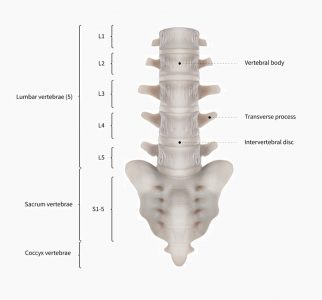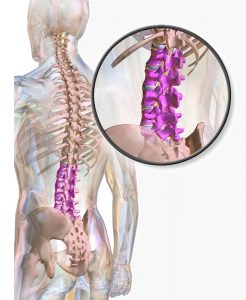Lumbar Vertebrae Definition
The lumbar vertebrae are bones that make up the spinal column or backbone, specifically within the lower back. These bones are below the cervical and thoracic vertebrae but above the sacrum or pelvis. They are the largest of the unfused vertebrae, and are larger than the bones located above. There are five lumbar vertebrae in humans, referred to as L1 through L5. L1 is closest to the thoracic vertebrae, while L5 is adjacent to the pelvis.
They can be differentiated from the other vertebrae because they lack foramina in the transverse processes. They do not have ribs or facets to articulate with the ribs. These are found adjacent to the thoracic vertebrae in humans, as well as cervical vertebrae in some species—such as lizards. These bones produce a concave curvature to the lower back.
Lumbar Vertebrae Function
The lumbar vertebrae’s function is to support the great weight of the body and allow certain movements, such as lifting objects. The lumbar vertebrae flex and extend through rotation between the vertebrae and movements in the sagittal plane between them. Animals with fewer lumbar vertebrae—such as gorillas and chimpanzees—tend to lack the ability to curve their lumbar spines when compared to humans.
These bones also protect the spinal cord and nerves from injury and provide a measure of support. The lumbar vertebrae are the biggest vertebral bones. They increase in size further down the spine in order to support the increasing weight of the body.
The lumbar spine is highlighted in the below image:
Lumbar Vertebrae Structure
The lumbar vertebrae have a central body, also known as the centrum. This is large and mostly flattened, and it supports most of the body’s weight. The body is roughly kidney-shaped in most animals and is composed of a cancellous bone center, with a cortical bone shell around the outside.
The body has a concave shape where the intervertebral discs are located. These are fibrous connective tissue discs. The outer layer is known as the annulus fibrosus and permits a small degree of motion and holds the vertebrae in place. The inner layer—the nucleus pulposus—is gel-like and absorbs shock between the vertebrae to minimize pressure placed on the lower back.
The pedicles help form the vertebral arch and are strong bones directed backward from the body. They have strong, short laminae that make up part of the arch. The laminae get shorter and wider as the vertebrae go down. The arch makes a triangular vertebral foramen in each of the vertebrae, which is larger than the foramen found in the thoracic vertebrae but not as large as that of the cervical vertebrae. This foramen allows the spinal cord, meninges, and cauda equina to pass through.
The lumbar vertebrae have processes similar to those of the other vertebrae. They have a thick, broad spinous process with sets of articular processes that project between the pedicles and laminae. The transverse processes are long, slender, bony projections. These are similar to the ribs found in the thoracic vertebrae but are shorter and smaller. In the lower lumbar vertebrae, there are three tubercles present: the costiform process, mammillary process, and accessory process. The bony processes of the lumbar vertebrae provide muscle attachment points, such as for the psoas major and multifidus muscles.
L5 has a slightly different shape than the other lumbar vertebrae. It has a body that is bigger in the front, unlike the others where the body is deeper in the back portion of the centrum. It also has a smaller spinous process, with thicker transverse processes which can arise from the pedicles or the body. The spinous process has a four-sided shape and comes to a thick notch.
Why is it Important
L5 is a common site of spondylolisthesis and spondylolysis. Spondylolisthesis is forward displacement of the vertebra when compared to the bone below it. Spondylolysis is a stress fracture or defect in the vertebral arch, which tends to present asymptomatically in most patients. Individuals with fewer or more lumbar vertebrae generally have the last lumbar bone affected with these disorders.
A variety of disorders can affect the lumbar vertebrae, similar to those affect the other vertebrae. Disc herniation is possible, and can put pressure on the spinal cord and cauda equina. Fractures, ligamentous injuries, and muscle strains are also possible with the lower back. Muscle injuries are especially common, given the fact that the lumbar spine supports a great deal of the body’s weight.
In addition, inflammatory diseases including spondylitis, rheumatoid arthritis, and psoriatic arthritis can occur. Tumors or cancer can occur within the lumbar spine, usually secondary to carcinomas. Infections within the bone, spinal cord, or meninges are possible, too.
Quiz


